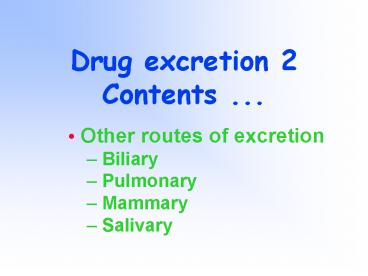Drug excretion 2 Contents ''' - PowerPoint PPT Presentation
1 / 13
Title:
Drug excretion 2 Contents '''
Description:
Significant for other reasons. Mammary - Delivery to baby. Salivary ... Bile formed in large volumes in the liver. Most of the ... Heroin: Prolonged ... – PowerPoint PPT presentation
Number of Views:229
Avg rating:3.0/5.0
Title: Drug excretion 2 Contents '''
1
Drug excretion 2Contents ...
- Other routes of excretion
- Biliary
- Pulmonary
- Mammary
- Salivary
2
Routes of excretion
Major routes of elimination
- Renal ?
- Biliary
- Pulmonary
Significant for other reasons
- Mammary - Delivery to baby
- Salivary - Drug monitoring
3
Biliary excretion
Bile formed in large volumes in the liver Most
of the water re-absorbed Concentrated bile
stored in the gall bladder Bile secreted into
the upper small intestine
4
Biliary excretion
- Similar to kidneys
- Lipid soluble drugs filter initially, but get
re-absorbed along with the bulk of the water.
Not excreted efficiently. - Acids and bases have active secretion mechanisms.
- BUT
- only works effectively if Mol Wt high enough.
Limit varies for different species. (gt300-500
for humans)
5
Biliary excretion
- Most drugs Mol Wt too low for efficient biliary
excretion. - Conjugation to glucuronide often increases Mol Wt
sufficiently for biliary excretion. - Acetate or glycine generally too small.
- Bile is significant route of excretion for
- Glucuronide conjugates (e.g. morphine)
- Limited number of ionised drugs with very high
- Mol Wt (e.g. cromoglycate)
6
Entero-hepatic circulation
Free
Conjugates in bile
Liver
Conjugates
Free
Small intestine
Colon
Mainly bacteria in colon that hydrolyse the
conjugates
7
Pulmonary excretion
Excretion via the lungs and breath. Significant
route of excretion for some volatile molecules -
especially anaesthetics.
8
Mammary - (milk)
- No active secretion, just passive diffusion.
- Concentration in milk reflects free
concentration in blood (apart from ion trapping). - Milk is slightly acid (pH 7.0) compared to
blood (pH 7.4).
9
Erythromycin in milk
Blood (pH 7.4) Milk (pH 7.0)
Non-ionised Non-ionised
Ionised Ionised
Lipid
Erythromycin concentrations approx 8 times higher
in milk than blood.
10
Drugs in milk -clinical significance
- Mainly the effect of the drug on the baby. e.g.
- Chloramphenicol Possible bone marrow
suppression. - Diazepam Accumulation and sedation.
- Heroin Prolonged neonatal dependence.
- Methadone Possible withdrawal syndrome if
breast feeding stopped suddenly. - Propylthiouracil Suppression of thyroid
function. - Tetracycline Permanent staining of infant teeth
11
Saliva
- Significant because of possible use in drug
monitoring. - Pharmacokinetic experiments often need serial
blood samples (10 or more). Ethical approval?
Saliva sampling is non-invasive. - Neutral molecules - salivary concentrations do
- reflect free concentrations in plasma. Has
been - used for antipyrine.
- Ionised drugs are a problem. Saliva pH is
- variable - variable degree of ion trapping.
12
Terms with which you should be familiar ...
- Biliary excretion
- Pulmonary excretion
- Mammary excretion
- Salivary excretion
- Enterohepatic circulation
13
What you should be able to do
- Describe how drugs may be added to or removed
from bile, including the significance of
molecular weight. - Describe the process of enterohepatic
circulation. - Describe the movement of drugs into milk and
the possible consequences for the baby. - Describe the potential for replacing blood
sampling by saliva sampling.































